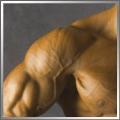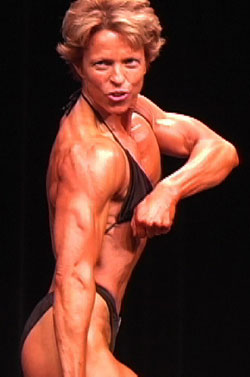|
Lying Rolling Floor Laterals...Simply THE Most Powerful,
Results-Producing Rear Delt Exercise You Will EVER Use
 The rear delts (one of the three muscle heads of the shoulder) are among the hardest muscles groups to properly target. They are not glamorous and they aren't a showpiece muscle so they are often ignored or neglected. Big mistake!
The rear delts (one of the three muscle heads of the shoulder) are among the hardest muscles groups to properly target. They are not glamorous and they aren't a showpiece muscle so they are often ignored or neglected. Big mistake!
The rear delts play an extremely important role not only in physique development but in strength and stabilization of the shoulder joint, which is CRITICAL for exercises like the bench press, as well for maintaining proper posture throughout the day. The rear delts help keep those shoulders back!
Strong rear delts that are in balance with the rest of the shoulder muscle heads (front and side) are VERY important. Well-developed rear delts will also really set you apart in terms of physique development.
The gold standard rear delt lateral raise (and variations of it) is commonly accepted as the best way to isolate and develop the rear delts. But, as good as it is, the rear delt lateral raise has several problems...
[Please note when I make these points, I'm not saying the rear delt lateral raise is a bad exercise and shouldn't be done. When properly done, it is an excellent rear delt exercise that works very well. However, as with any exercise, it does have its problems.]
1. The bent-over body position (which is the typical form for the exercise) places continuous stress on the lower back and can lead to torso bouncing to help get the weight moving, not to mention blood pressure issues from exercising in that position.
If you've got lower back pain, this eliminates the exercise for you right away. If you don't have lower back pain, doing the exercise with a short bounce to get the weight started can actually lead to lower back pain. The back is simply not in a good position to be bouncing.
This problem with the bent-over position can be removed by laying face down on an incline or flat bench, but this leads us to the second problem with the exercise.
 2. The exercise offers very little resistance at the start of the movement leading up to maximum resistance at the top. While this results in a good contraction at the top, your rear delts don't really get that much meaningful work until you're at or near that top point. They don't get worked fully and therefore won't develop fully.
2. The exercise offers very little resistance at the start of the movement leading up to maximum resistance at the top. While this results in a good contraction at the top, your rear delts don't really get that much meaningful work until you're at or near that top point. They don't get worked fully and therefore won't develop fully.
If you use a lot of weight with this exercise to try and get more out of it, the muscles of the upper back will take over. If you use a very light weight to go for feel, you may not be stimulating the rear delts with enough resistance to actually get results. It's a Catch-22 situation and neither option is ideal.
3. When the rear delts get tired, the upper back muscles take over. If you've been training regularly, you know the most productive part of a set is the last few reps when the muscles are really getting pushed to their limits. This is the stimulus that produces results. With bent-over rear laterals, when the small rear delt muscles become fatigued, the larger upper back muscles immediately kick in and take over the exercise, reducing the tension on the rear delts at the exact time when they should be getting the most out of the exercise.
So what do "Lying Rolling Floor Laterals" do to fix this problem?
First, I'm going to explain exactly how to do the exercise, then I'll tell you exactly why it's so effective and why it eliminates the problems found in the standard rear delt lateral.
HOW TO DO IT:
For this exercise, you will need one dumbell. Start with a light to moderate weight (similar to what you'd use for a rear lateral raise) until you get the hang of the movement.
Lie flat on your back on the floor with your legs perfectly stiff and completely straight. The soles of your feet should NOT be touching the floor. Hold the dumbell directly above your chest in your left hand (arm straight and stiff) and lay your right arm flat on the floor directly to the side with your palm facing up.
Now, keeping your left arm stiff and straight, lower the dumbell down towards your right hand, rolling your entire body onto your right side as you do so. To start the roll onto your side, all you need to do is start bringing the dumbell over and around a little. The weight of the dumbell will start your body rolling over.
 DO NOT LET IT DROP! This should be a very controlled movement all the way down. If you had to, you should be able to stop at any given point along the way. Push your entire right arm hard against the floor to help control the descent of the left arm.
DO NOT LET IT DROP! This should be a very controlled movement all the way down. If you had to, you should be able to stop at any given point along the way. Push your entire right arm hard against the floor to help control the descent of the left arm.
At the bottom of the movement, you should be laying completely on your side (legs still stiff and straight) with the dumbell laying on top of your bottom hand as though clapping.
Now you're going to go the other way. Do a rear delt lateral raise with the left hand (that's holding the dumbell), raising your arm back to vertical.
CRITICAL POINT - As you do this lateral raise with the left arm, push down hard against the floor with your entire right arm. It should feel as though you are trying to open both of your arms out wide as you raise the dumbell and roll your body towards your back. This means you'll be not only working the rear delt of the left side with a dumbell lateral raise, you'll be working the rear delt of the right side while you push against the floor and rotate your body.
This push and roll makes the exercise into a bodyweight exercise for the rear delts...exercises that move your body through space activate more muscle fibers than exercises that simply move the resistance. This exercise accomplishes both types of movements at the same time!
When your left arm is vertical, you should be laying flat on your back again. Carefully switch the dumbell over to your right hand then lay your left arm flat on the ground, palm facing up. As before, lower the dumbell down and around and roll onto your left side, pushing down against the ground with your entire left arm, using the left arm to control the descent.
 Be absolutely sure to keep your legs stiff and perfectly straight through the entire exercise. If your knees are bent or your feet are on the floor, you will be more likely to push against the ground with your feet, removing tension from the arm that's pushing against the floor. ALL the pushing should be done at the shoulder.
Be absolutely sure to keep your legs stiff and perfectly straight through the entire exercise. If your knees are bent or your feet are on the floor, you will be more likely to push against the ground with your feet, removing tension from the arm that's pushing against the floor. ALL the pushing should be done at the shoulder.
Keep repeating this maneuver for a full set of 6 to 8 reps. It will take a few sets through to get an idea of how much weight you can use so don't be afraid to experiment. If you use too much weight, you won't be able to control the descent of the dumbell and it will drop down into your other hand. If you use too light a weight, you won't feel the exercise as strongly, so be sure to add weight if and when you can.
WHY THIS EXERCISE IS SO EFFECTIVE:
This exercise is extremely effective for a number of reasons:
1. No lower back stress. Since you're lying flat on your back with your legs straight, it puts zero pressure on the lower back. There is some cross-tension in the back due to the opposing movements of the arms, however. The body position of this exercise also eliminates much of the blood pressure problem that occurs with the standard bent-over exercise (this exercise does require some abdominal stabilization, which will have an effect on blood pressure - no more so than any other exercise, however).
2. It's a body-moving exercise. As I explained above, exercises that move your body through space will activate more muscle fibers.
3. You get tension through a greater range of motion of the rear delt. Rather than just getting tension in the contracted position of the exercise, you get it almost all the way from start to finish. Granted, you lose tension at the top, but supersetting or following this exercise with a variation of the standard rear delt lateral raises will address this.
4. You get an extremely effective and controllable negative on the rear delts. The negative or lowering portion of the movement of a standard bent-over lateral raise is extremely difficult to control and properly target to the rear delts due to the position of your body and the tendency for the larger muscles of the upper back to take over. This exercise eliminates that problem and forces ALL the tension of the negative onto both rear delts at the same time (the arm with the dumbell fighting the lowering and the arm on the floor, pushing against the ground). These two opposing forces allow for an extremely intense and effective negative (you'll feel this one for days the first time you do it).
CONCLUSION:
If you've never felt your rear delts after a shoulder workout, this exercise will help you feel EXACTLY where those are! Regular use of this exercise will help you develop your rear delts to their maximum potential far more quickly and effectively than any other single exercise you can do for them.

More Articles by Author Nick Nilsson
Return To Weight Lifting Articles Archive
|